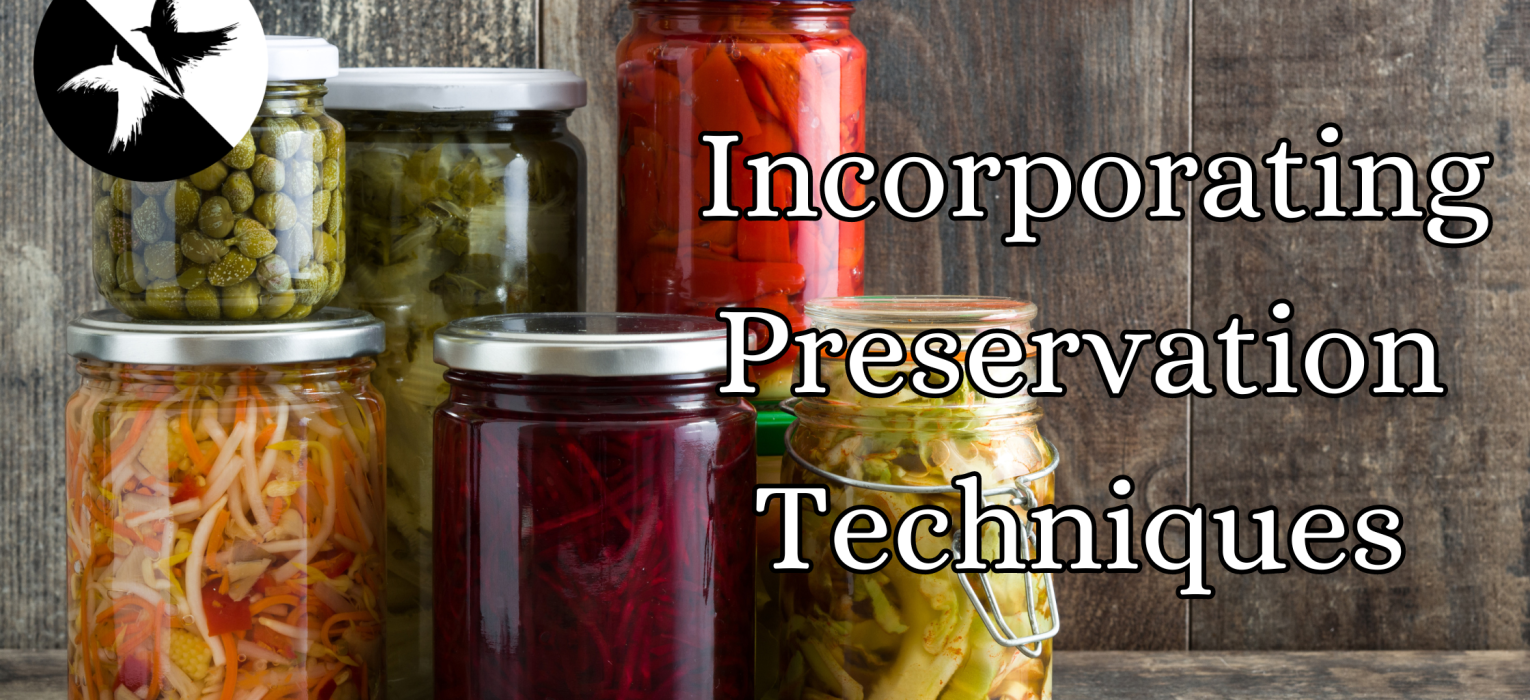Did you know shrimp can be pickled? What is a zeer pot? What the heck is water glassing? How could you end up with a salted apple? Find out on this episode!
Welcome to Writing Rural with Alley, the fiction writer’s inspiration station for rural life and lifestyles, from historical to post-apocalyptic, helping you bring your rural stories to life! I’m Alley, and this is episode (#) (title). Stick around to the end to find out all the ways things could possibly go wrong. Now, let’s get into this.
Whether your characters have a garden, forage for food, or have meat, there are many methods that are used, have been used, and might be used in an apocalypse. Today, we will cover five more of them.
16) Pickling
Pickling is a preservation method that combines water, vinegar, salt, and sugar. A basic ratio is 100% vinegar, 50% water, 25% sugar, and 12.5% kosher salt by weight. Is anyone else confused about that, or was it just me? Let me try this in grams. In grams, that equals 200g vinegar, 100g water, 50g sugar, and 25g kosher salt. This is easy to scale up or down as needed. When combined, this is called a pickle brine. Or another way to look at it, a ratio of 8 units of vinegar to 4 units of water to 2 units of sugar to 1 unit of kosher salt. (That sounds like a lot of salt!)
Pickling is done much the same as canning after your brine. Vegetables are chopped up and placed in jars. The brine is poured in. Your character will take care of the air bubbles, then give them a hot water bath and check their seals. Once they are done and cooled, they will be good for at least one year on the shelf at room temperature.
There is a long list of things that can be pickled. These include, but are not limited to, pickles (who’d have guessed?), avocados, peaches, shrimp, beets, orange peels, jalapeno rings, walnuts, asparagus, stems of leafy greens, turmeric roots, blueberries, okra, eggs, peppers, green beans, radish, garlic, ginger, onions, carrots, Brussels sprouts, corn on the cob, mushrooms, snap peas, apples, watermelon, squash, and many more.
17) Sugaring
Sugar, yes, you heard that right! Believed to have originated in the Middle East, sugaring has been around for several thousands of years. When sugar is added, it causes an osmotic effect. That is a fancy way of saying it draws the water out of the fruit and vegetables but is mainly used for fruit. This creates an environment that is hard for microbes to live in and slows food spoiling.
Sugaring requires sugar, water, and lemon juice, although salt and other preservatives can be used at the same time. This process is much the same as pickling. Chop up the food and place it in the jars. Boil the water and sugar. Once the sugar is dissolved, add the lemon juice. Pour into the jars covering the food. Get rid of bubbles. Then, give them a water bath and check the seals. Some of the most common foods for this are bananas, apples, pears, plums, apricots, carrots, ginger, and onions.
18) Zeer pot / Charcoal pot
Zeer pots, sometimes called charcoal pots, are very neat non-electric coolers. They originated in rural Africa and the Middle East. They were rediscovered in 1995 by Mohammed Bah Abba, a teacher from northern Nigeria. He patented it and helped with the repopularization of it.
I will quote the definition from instructables.com because I can’t give you a better one. They say, and I quote,” They consist of two terra cotta pots, one nested inside the other, with the gap between them filled with wet sand. The sand serves as a thermal mass that helps keep the pot cold once it has cooled down and acts as a wick to spread the moisture up the walls of the pot. When placed in a shaded, breezy location, the evaporation of water off the outer surface chills the pot. If you have a good breeze or a fan powered by a solar panel blowing the pot, the pot can get quite cold.” End quote.
Some people also use charcoal instead of sand. This also works if the larger chunks have been removed. It doesn’t get quite as cold as a refrigerator, but it will keep food cooler and extend its life.
19) Vinegar
Vinegar makes this list as it is used in many different types of food preservations. It dates all the way back to 3,000 BC and helps to kill microbes while inhibiting new growth. It is used in pickling, sugaring, cheese making, and fermenting and can be used in canning. That’s why vinegar makes this list. It can also be used to wipe down food before cutting to remove any microbes on the outside of the food. This is important if it is in a questionable spot. Your character wants as few microbes as they can get. But they might take chances if they are hungry or low on food. It is also good for wiping down cutting boards before food is chopped up on it and between batches. Vinegar is also a favorite to store herbs, spices, and many dressings.
20) Water glassing (FDA advises that lime can contain botulinum.)
Water glassing is a method of egg preservation. This involves water and pickling lime. Your character will need clean, unwashed eggs to pickle. Both clean and unwashed are important! Clean so they do not sit in poop. Unwashed, because when eggs are washed, it opens tiny holes from the outside to the inside of the egg, letting the lime seep into the egg. Pickling lime is not meant for human consumption. That is why it is important to make sure no cracked eggs go in and to check them when you take them out, along with rinsing off the lime solution.
The way to make them is to add one ounce of pickling lime for every one quart of water. Stir them well! Place clean, unwashed eggs, pointy side down into the jar. In a half-gallon jar, you can fit roughly 17 eggs. Fill with lime solution, and add a lid. Now, place them in a cool, dry place, and they will last between 12 to 18 months. I should add that the FDA advises not to do this as lime has been known to carry botulism. I’ve never seen anyone get it from water glass eggs, but I’ve also never seen anyone hit with lightning. I know they both happen; I just haven’t seen it personally, nor do I want to!
Fun fact: Any type of egg can be water glassed as long as it is clean and unwashed.
What could possibly go wrong?
Likely to go wrong: Your character uses vinegar, and it gets into a wound. This would feel like a burning pain.
Likely to go wrong: Your character added too much vinegar to salad dressing, and now it tastes more like vinegar than anything else.
Possible to go wrong: Your character notices the lime settling at the bottom of a jar of water-glass eggs. They decide to shake it up, and they crack the eggs, causing them to be inedible.
Possible to go wrong: Your character didn’t check the pickling jar lids after their water bath to make sure they were sealed. When they go to eat their pickles, they find they are rotten.
Unlikely to go wrong: Your character placed store-bought eggs in pickling lime, thinking they would work and not knowing they had been washed before they were bought. When they eat them, they contract botulism.
Unlikely to go wrong: Your character is trying to sugar some fruit to preserve it, but they mistakenly use salt. The food might go bad, or when they bite into their sugared apple, they get a mouth full of salted apple.
Improbable but still technically in the realm of possibilities: Your character uses a zeer pot, and things are going great. Then, one day, their child decides it would be the perfect thing to jump over. The child misjudges the leap and knocks the pot over, shattering it.
Improbable but still technically in the realm of possibilities: Your character badly misreads the pickling recipe. When they pull their food out to eat it, it tastes so salty they become nauseous.
Helpful Links To Learn More:
Pickling:
https://www.eatingwell.com/article/114109/how-to-pickle-anything-no-canning-necessary/
Sugaring:
https://www.sugarnutritionresource.org/news-articles/sugar-as-a-preservative
https://makefoodstay.com/sugaring-food-preservation/ https://ifood.tv/storage/sugaring/about
Zeer pot / Charcoal pot:
https://www.instructables.com/A-Practical-Zeer-Pot-evaporative-cooler-non-electr/?amp_page=true
https://www.survivalsullivan.com/how-to-make-a-zeer-pot/
https://www.greenlivingtips.com/articles/cooling-food-without-electricity.html
Vinegar:
https://www.gardeningknowhow.com/edible/vegetables/vgen/vinegar-pickling-garden-produce.htm
https://www.yellowpages.ca/tips/how-to-preserve-food-in-vinegar/
Waterglassing:



